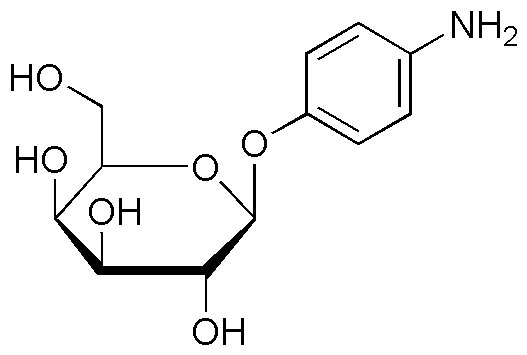4-Aminophenyl-b-D-galactopyranoside is widely utilized in research focused on:
- Biochemical Research: This compound serves as a substrate in enzyme assays, particularly for studying glycosyltransferases, which are crucial in carbohydrate metabolism.
- Drug Development: It is used in the synthesis of glycosylated compounds that can enhance the bioavailability and efficacy of pharmaceutical agents, making it valuable in medicinal chemistry.
- Diagnostics: The compound can be employed in the development of diagnostic tests, particularly in assays that require specific carbohydrate recognition, aiding in disease detection.
- Cell Biology: It is utilized in cell culture studies to investigate cell signaling pathways and receptor interactions, providing insights into cellular functions and disease mechanisms.
- Food Industry: This chemical can be explored for its potential applications in food science, particularly in the development of prebiotics that promote gut health.
General Information
Properties
Safety and Regulations
Applications
4-Aminophenyl-b-D-galactopyranoside is widely utilized in research focused on:
- Biochemical Research: This compound serves as a substrate in enzyme assays, particularly for studying glycosyltransferases, which are crucial in carbohydrate metabolism.
- Drug Development: It is used in the synthesis of glycosylated compounds that can enhance the bioavailability and efficacy of pharmaceutical agents, making it valuable in medicinal chemistry.
- Diagnostics: The compound can be employed in the development of diagnostic tests, particularly in assays that require specific carbohydrate recognition, aiding in disease detection.
- Cell Biology: It is utilized in cell culture studies to investigate cell signaling pathways and receptor interactions, providing insights into cellular functions and disease mechanisms.
- Food Industry: This chemical can be explored for its potential applications in food science, particularly in the development of prebiotics that promote gut health.
Documents
Safety Data Sheets (SDS)
The SDS provides comprehensive safety information on handling, storage, and disposal of the product.
Product Specification (PS)
The PS provides a comprehensive breakdown of the product’s properties, including chemical composition, physical state, purity, and storage requirements. It also details acceptable quality ranges and the product's intended applications.
Certificates of Analysis (COA)
Search for Certificates of Analysis (COA) by entering the products Lot Number. Lot and Batch Numbers can be found on a product’s label following the words ‘Lot’ or ‘Batch’.
Número de catálogo
Número de lote/lote
Certificates Of Origin (COO)
This COO confirms the country where the product was manufactured, and also details the materials and components used in it and whether it is derived from natural, synthetic, or other specific sources. This certificate may be required for customs, trade, and regulatory compliance.
Número de catálogo
Número de lote/lote
Safety Data Sheets (SDS)
The SDS provides comprehensive safety information on handling, storage, and disposal of the product.
DownloadProduct Specification (PS)
The PS provides a comprehensive breakdown of the product’s properties, including chemical composition, physical state, purity, and storage requirements. It also details acceptable quality ranges and the product's intended applications.
DownloadCertificates of Analysis (COA)
Search for Certificates of Analysis (COA) by entering the products Lot Number. Lot and Batch Numbers can be found on a product’s label following the words ‘Lot’ or ‘Batch’.
Número de catálogo
Número de lote/lote
Certificates Of Origin (COO)
This COO confirms the country where the product was manufactured, and also details the materials and components used in it and whether it is derived from natural, synthetic, or other specific sources. This certificate may be required for customs, trade, and regulatory compliance.


